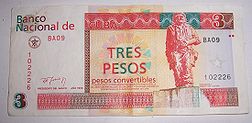- Cuban convertible peso
-
Cuban convertible peso peso cubano convertible (Spanish) 
Three convertible pesos ISO 4217 code CUC User(s)  Cuba
CubaInflation 5% Source The World Factbook, 2006 est. Pegged with convertible peso = 1.00 U.S. dollars Subunit 1/100 centavo convertible Symbol $, CUC or CUC$ centavo convertible ¢ or c Nickname chavito Coins Freq. used 1¢, 5¢, 10¢, 25¢, 50¢, $1 Rarely used $5 Banknotes $1, $3, $5, $10, $20, $50, $100 Central bank Central Bank of Cuba Website www.bc.gov.cu The convertible peso (sometimes given as CUC$) (informally called a chavito), is one of two official currencies in Cuba, the other being the peso. It has been in limited use since 1994, when it was treated as equivalent to the U.S. dollar: its value was officially US$1.00. On November 8, 2004, the U.S. dollar ceased to be accepted in Cuban retail outlets leaving the convertible peso as the only currency in circulation in many Cuban businesses. Officially exchangeable only within the country, its value was increased to US$1.08 on April 5, 2008, and reverted to US$1.00 on 15 March 2011[1]. The convertible peso is, by the pegged rate, the eleventh-highest-valued currency unit in the world and the highest valued "peso" unit.
Contents
History
From 1993 until 2004, the Cuban currency was split between the Cuban peso (the currency Cuban citizens are paid in and used for staples and non-luxury items) and the U.S. dollar in combination with the convertible peso, which was used for tourism and for luxury items.[citation needed] The Cuban peso(CUP) can be exchanged to the convertible peso (CUC) at the exchange offices (CADECA), at a fixed rate of 24 CUP to 1 CUC (sell) and 25 CUP to 1 CUC (buy).[1]; however, for state household book-keeping purposes, both pesos are valued at a 1:1 rate.[1]
On 8 November 2004, the Cuban government withdrew the U.S. dollar from circulation citing the need to retaliate against further U.S. sanctions.[2] After a grace period ending on November 14, 2004, a 10% surcharge began to be imposed when converting U.S. dollars into convertible pesos. The change was announced some weeks beforehand and was extended by the aforementioned grace period (it has been claimed this was because the amounts of US dollars being exchanged were more than anticipated).[citation needed] This measure helped the Cuban government collect hard currency.[citation needed]
Coins
In 1994, coins were introduced in denominations of 5, 10, 25 and 50 centavos, and 1 peso. 5 pesos (rarely seen) was introduced in 1999, followed by 1 centavo coins in 2000.
Banknotes
In 1994, the Banco Central de Cuba introduced notes in denominations of 1, 3, 5, 10, 20, 50 and 100 pesos.
The CUC and the U.S. dollar
Between April 2005 and March 2011, the convertible peso was worth 1.08 USD. The CUC is currently pegged to the U.S. dollar at 1:1, as it was between 1994 and 2005.[1]
When exchanging U.S. dollar banknotes a 10% tax is applied plus an exchange commission.[1] The 10% tax is not applied to other currencies,[3] bank transfers, or credit card payments.[citation needed]
For transactions using credit cards, the cards are charged in U.S. dollars plus an extra 3% service charge.[citation needed] (Credit cards issued by U.S. banks cannot be used in Cuba.[citation needed])
Current CUC exchange rates From Google Finance: AUD CAD CHF EUR GBP HKD JPY USD From Yahoo! Finance: AUD CAD CHF EUR GBP HKD JPY USD From OzForex: AUD CAD CHF EUR GBP HKD JPY USD From XE.com: AUD CAD CHF EUR GBP HKD JPY USD From OANDA.com: AUD CAD CHF EUR GBP HKD JPY USD Note: Rates obtained from these websites may contradict with pegged rate mentioned above.
See also
References
- ^ a b c d e "Política Monetaria". Bc.gov.cu. http://www.bc.gov.cu/Espanol/Acuerdo30-11.asp. Retrieved 2011-09-30.
- ^ "Cuba's currency: Adios to the greenback". The Economist. 2004-10-28. http://www.economist.com/node/3339738. Retrieved 2011-09-30.
- ^ "Centro de Promoción del Comercio Exterior y la Inversión Extranjera de Cuba - CEPEC". Cepec.cu. http://www.cepec.cu/informacionsistema.php. Retrieved 2011-09-30.
Currencies named peso or similar Circulating - Argentine peso
- Chilean peso
- Colombian peso
- Cuban convertible peso
- Cuban peso
- Dominican peso (peso oro)
- Macanese pataca (圓)
- Mexican peso
- Philippine peso(piso)
- Uruguayan peso
Obsolete - Argentine peso argentino
- Argentine peso ley
- Argentine peso moneda corriente
- Argentine peso moneda nacional
- Bolivian peso
- Catalan peseta (pesseta)
- Costa Rican peso
- Ecuadorian peso
- Equatorial Guinean peseta
- Guatemalan peso
- Guinea-Bissau peso
- Honduran peso
- Japanese government-issued Philippine fiat peso
- Nicaraguan peso
- Paraguayan peso
- Peruvian peseta
- Portuguese Timorese pataca
- Puerto Rican peso
- Sahrawi peseta
- Salvadoran peso
- Spanish peso
- Spanish peseta (pesseta, pezeta)
- Venezuelan peso
See also - Peso sign
- Maltese pataca (coin)
External links
Categories:- Peso
- Currencies of the Americas
- Circulating currencies
- Economy of Cuba
- Fixed exchange rate
Wikimedia Foundation. 2010.
